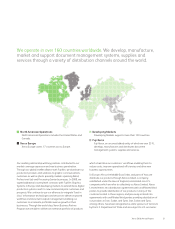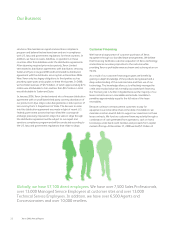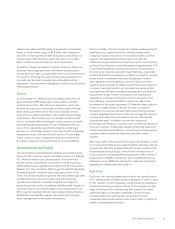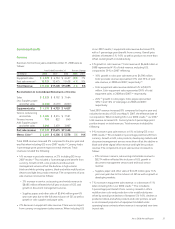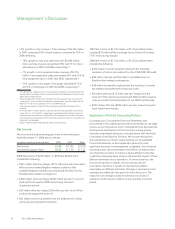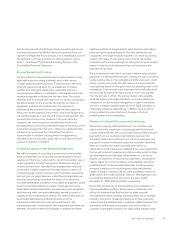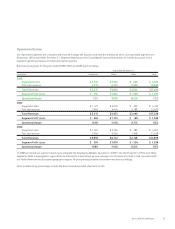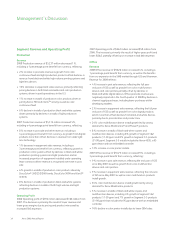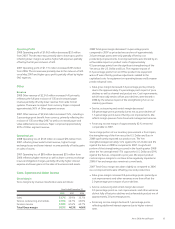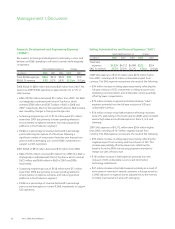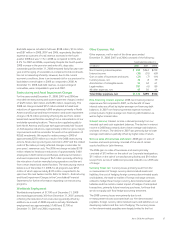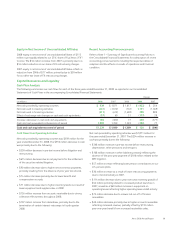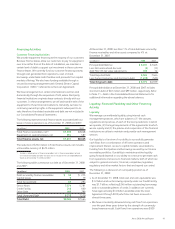Xerox 2008 Annual Report Download - page 33
Download and view the complete annual report
Please find page 33 of the 2008 Xerox annual report below. You can navigate through the pages in the report by either clicking on the pages listed below, or by using the keyword search tool below to find specific information within the annual report.
we consider the Moody’s Aa Corporate Bond Index and the
International Index Company’s iBoxx Sterling Corporate AA Cash
Bond Index, respectively, in the determination of the appropriate
discount rate assumptions. Due to the recent, unprecedented
events in the financial markets associated with the current credit
environment, there is a greater than usual disparity in yields
among the bonds included in the various indices used to determine
our pension discount rates. Given this disparity, we carefully
evaluated our existing methodologies for determining our pension
discount rates and refined those methodologies to the extent
required to ensure we selected an appropriate discount rate. The
weighted average discount rate we utilized to measure our pension
obligation as of December 31, 2008 and to calculate our 2009
expense was 6.3%, which is an increase of 0.4% from 5.9% used
in determining our 2008 expense. The increase is primarily driven
by our U.K. and Canadian plans.
Assuming settlement losses in 2009 are consistent with 2008, our
2009 net periodic defined benefit pension cost is expected to be
approximately $20 million higher than 2008, primarily as a result
of the reduction in the expected return on plan assets due to lower
asset values and increased amortization of actuarial gains and
losses partially offset by an increase in the discount rate.
On a consolidated basis, we recognized net periodic pension cost of
$254 million, $315 million and $425 million for the years ended
December 31, 2008, 2007 and 2006, respectively. The costs
associated with our defined contribution plans, which are included
in net periodic pension cost, were $80 million, $80 million and $70
million for the years ended December 31, 2008, 2007 and 2006,
respectively. Pension cost is included in several income statement
components based on the related underlying employee costs.
Pension and post-retirement benefit plan assumptions are included
in Note 14 – Employee Benefit Plans in the Consolidated Financial
Statements. Holding all other assumptions constant, a 0.25%
increase or decrease in the discount rate would (decrease)/increase
the 2009 projected net periodic pension cost by $(13) million or
$18 million, respectively. Likewise, a 0.25% increase or decrease in
the expected return on plan assets would change the 2009
projected net periodic pension cost by $11 million.
Income Taxes and Tax Valuation Allowances
We record the estimated future tax effects of temporary
differences between the tax bases of assets and liabilities and
amounts reported in our Consolidated Balance Sheets, as well as
operating loss and tax credit carryforwards. We follow very specific
and detailed guidelines in each tax jurisdiction regarding the
recoverability of any tax assets recorded in our Consolidated
Balance Sheets and provide valuation allowances as required. We
regularly review our deferred tax assets for recoverability
considering historical profitability, projected future taxable income,
the expected timing of the reversals of existing temporary
differences and tax planning strategies. If we continue to operate
at a loss in certain jurisdictions or are unable to generate sufficient
future taxable income, or if there is a material change in the actual
effective tax rates or time period within which the underlying
temporary differences become taxable or deductible, we could be
required to increase the valuation allowance against all or a
significant portion of our deferred tax assets resulting in a
substantial increase in our effective tax rate and a material adverse
impact on our operating results. Conversely, if and when our
operations in some jurisdictions were to become sufficiently
profitable to recover previously reserved deferred tax assets, we
would reduce all or a portion of the applicable valuation allowance
in the period when such determination is made. This would result in
an increase to reported earnings in such period. Adjustments to our
valuation allowance, through charges to income tax expense, were
$17 million, $14 million and $12 million for the years ended
December 31, 2008, 2007 and 2006, respectively. There were
other (decreases) increases to our valuation allowance, including
the effects of currency, of $(136) million, $86 million and $45
million for the years ended December 31, 2008, 2007 and 2006,
respectively, that did not affect income tax expense in total as
there was a corresponding adjustment to deferred tax assets or
other comprehensive income. Gross deferred tax assets of $3.8
billion and $3.6 billion had valuation allowances of $628 million
and $747 million at December 31, 2008 and 2007, respectively.
We are subject to ongoing tax examinations and assessments in
various jurisdictions. Accordingly, we may incur additional tax
expense based upon our assessment of the more-likely-than-not
outcomes of such matters. In addition, when applicable, we adjust
the previously recorded tax expense to reflect examination results.
Our ongoing assessments of the more-likely-than-not outcomes of
the examinations and related tax positions require judgment and
can materially increase or decrease our effective tax rate as well as
impact our operating results.
We file income tax returns in the U.S. Federal jurisdiction and
various foreign jurisdictions. In the U.S. we are no longer subject to
U.S. Federal income tax examinations by tax authorities for years
before 2007. With respect to our major foreign jurisdictions, we are
no longer subject to tax examinations by tax authorities for years
before 2000.
Legal Contingencies
We are involved in a variety of claims, lawsuits, investigations and
proceedings concerning securities law, intellectual property law,
environmental law, employment law and ERISA, as discussed in
Note 16 – Contingencies in the Consolidated Financial Statements.
We determine whether an estimated loss from a contingency
should be accrued by assessing whether a loss is deemed probable
Xerox 2008 Annual Report 31


